Systems Analysis of the Response of Photosynthesis, Metabolism, and Growth to an Increase in Irradiance in the Photosynthetic Model Organism Chlamydomonas reinhardtii
- PMID: 24894045
- PMCID: PMC4114937
- DOI: 10.1105/tpc.114.124537
Systems Analysis of the Response of Photosynthesis, Metabolism, and Growth to an Increase in Irradiance in the Photosynthetic Model Organism Chlamydomonas reinhardtii
Abstract
We investigated the systems response of metabolism and growth after an increase in irradiance in the nonsaturating range in the algal model Chlamydomonas reinhardtii. In a three-step process, photosynthesis and the levels of metabolites increased immediately, growth increased after 10 to 15 min, and transcript and protein abundance responded by 40 and 120 to 240 min, respectively. In the first phase, starch and metabolites provided a transient buffer for carbon until growth increased. This uncouples photosynthesis from growth in a fluctuating light environment. In the first and second phases, rising metabolite levels and increased polysome loading drove an increase in fluxes. Most Calvin-Benson cycle (CBC) enzymes were substrate-limited in vivo, and strikingly, many were present at higher concentrations than their substrates, explaining how rising metabolite levels stimulate CBC flux. Rubisco, fructose-1,6-biosphosphatase, and seduheptulose-1,7-bisphosphatase were close to substrate saturation in vivo, and flux was increased by posttranslational activation. In the third phase, changes in abundance of particular proteins, including increases in plastidial ATP synthase and some CBC enzymes, relieved potential bottlenecks and readjusted protein allocation between different processes. Despite reasonable overall agreement between changes in transcript and protein abundance (R2 = 0.24), many proteins, including those in photosynthesis, changed independently of transcript abundance.
© 2014 American Society of Plant Biologists. All rights reserved.
Figures
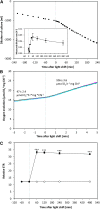
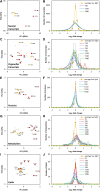

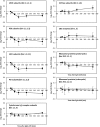


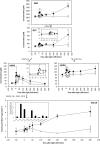



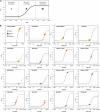

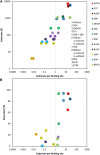


Similar articles
-
Overexpression of Sedoheptulose-1,7-Bisphosphatase Enhances Photosynthesis in Chlamydomonas reinhardtii and Has No Effect on the Abundance of Other Calvin-Benson Cycle Enzymes.Front Plant Sci. 2020 Jun 23;11:868. doi: 10.3389/fpls.2020.00868. eCollection 2020. Front Plant Sci. 2020. PMID: 32655601 Free PMC article.
-
Relationship between irradiance and levels of Calvin-Benson cycle and other intermediates in the model eudicot Arabidopsis and the model monocot rice.J Exp Bot. 2019 Oct 24;70(20):5809-5825. doi: 10.1093/jxb/erz346. J Exp Bot. 2019. PMID: 31353406 Free PMC article.
-
Targeted metabolite profiling as a top-down approach to uncover interspecies diversity and identify key conserved operational features in the Calvin-Benson cycle.J Exp Bot. 2021 Sep 2;72(17):5961-5986. doi: 10.1093/jxb/erab291. J Exp Bot. 2021. PMID: 34473300 Free PMC article.
-
Regulation of Calvin-Benson cycle enzymes under high temperature stress.aBIOTECH. 2022 Jan 24;3(1):65-77. doi: 10.1007/s42994-022-00068-3. eCollection 2022 Mar. aBIOTECH. 2022. PMID: 36311539 Free PMC article. Review.
-
Mechanisms controlling metabolite concentrations of the Calvin Benson Cycle.Semin Cell Dev Biol. 2024 Mar 1;155(Pt A):3-9. doi: 10.1016/j.semcdb.2023.02.009. Epub 2023 Feb 28. Semin Cell Dev Biol. 2024. PMID: 36858897 Review.
Cited by
-
Non-photochemical quenching-dependent acclimation and thylakoid organization of Chlamydomonas reinhardtii to high light stress.Photosynth Res. 2019 Mar;139(1-3):387-400. doi: 10.1007/s11120-018-0551-7. Epub 2018 Jul 7. Photosynth Res. 2019. PMID: 29982908
-
Transient expression in Nicotiana benthamiana for rapid functional analysis of genes involved in non-photochemical quenching and carotenoid biosynthesis.Plant J. 2016 Nov;88(3):375-386. doi: 10.1111/tpj.13268. Epub 2016 Sep 15. Plant J. 2016. PMID: 27407008 Free PMC article.
-
A refined genome-scale reconstruction of Chlamydomonas metabolism provides a platform for systems-level analyses.Plant J. 2015 Dec;84(6):1239-56. doi: 10.1111/tpj.13059. Epub 2015 Nov 30. Plant J. 2015. PMID: 26485611 Free PMC article.
-
The maximum growth rate hypothesis is correct for eukaryotic photosynthetic organisms, but not cyanobacteria.New Phytol. 2021 Apr;230(2):601-611. doi: 10.1111/nph.17190. Epub 2021 Feb 24. New Phytol. 2021. PMID: 33449358 Free PMC article.
-
Why is primary endosymbiosis so rare?New Phytol. 2021 Sep;231(5):1693-1699. doi: 10.1111/nph.17478. Epub 2021 Jun 21. New Phytol. 2021. PMID: 34018613 Free PMC article. Review.
References
-
- Ainsworth E.A., et al. (2008). Next generation of elevated [CO2] experiments with crops: a critical investment for feeding the future world. Plant Cell Environ. 31: 1317–1324. - PubMed
-
- Amthor J.S. (2010). From sunlight to phytomass: on the potential efficiency of converting solar radiation to phyto-energy. New Phytol. 188: 939–959. - PubMed
-
- Anderson J.M. (1992). Cytochrome b6f complex: Dynamic molecular organization, function and acclimation. Photosynth. Res. 34: 341–357. - PubMed
LinkOut - more resources
Full Text Sources
Other Literature Sources
Molecular Biology Databases

